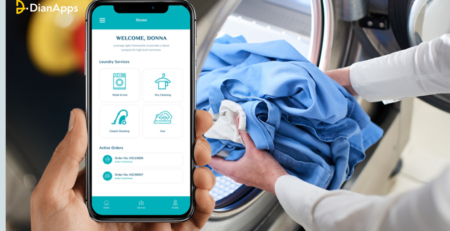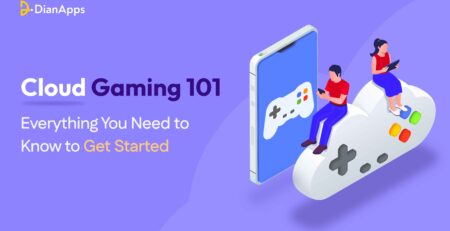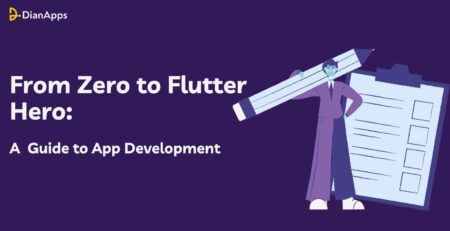12 Best Practices for Streamlined Flutter Apps in Business
Google, an American multinational technology company, released the Flutter framework in May 2017. Even though it faced some hardship during its initial phase, the framework soon caught up in its fame in combatant to React Native app development.
But, how did Flutter app development become a popular open-source UI toolkit so quickly? The reasons can be many, starting from its cross-platform compatibility, and fast development cycle, to UI customization, and highly modern app development trends that keep changing to beat the competition in the market.
As per internet surveys from February 2023, in a debate between Flutter vs React Native, Flutter holds 12.64% of the developers group while React Native is only a few steps behind with 12.57% of developers using the framework regularly.
To add more, Flutter is considered the “most loved technology” in the Stack Overflow Survey of 2022 with 68.03% of its usage. The app development framework has 487,428 repositories while React Native stands at 366,832 results.
While that’s about 2023, Flutter app development services is expected to become more mature. Let’s know Flutter’s 12 best practices that are simple to understand and implement in 2024.
Flutter Best Practices For Mobile App Development in 2024
Your Flutter app development services should evolve with time. The best way to do this is by adhering to the best practices in Flutter development. Through this, mobile app developers can embrace the quality, readability, maintainability, and robustness of their code.
The following best practices will further improve the way you collaborate among developers and make your business workflow even more efficient. This means you get to manage your app development requirements in one platform with the help of a mobile app development company.
1. Employ Latest Flutter 3.16 To Boost Your App Productivity
In November 2023, Flutter released its new version that is built upon the foundation laid by the previous 3.13 update. 3.16 update induces a series of updates and improvements across its ecosystem, each aimed at empowering developers’ experience and app performance.
- Framework:
Developers are welcomed with fresh and updated component graphics, making the shift away from Material 2 easier. Material 3 is now the default theme.
- Engine:
To improve graphical performance and invite developer feedback through a preview, a Vulkan backend for Impeller on Android has been included, strengthening the engine.
- Games:
To help developers create captivating mobile games, the Flutter Casual Games Toolkit has been enhanced with additional tools, like as templates and integrations tailored to specific genres.
- Platform:
Flutter expands its ability to offer a larger range of app extensions on iOS, and Android users enjoy a more responsive mouse scroll wheel interface.
- Package Ecosystem:
With the addition of new Flutter Favorites, which highlight outstanding packages that support active app development, the package ecosystem is reinforced. Read the top 10 Flutter Packages to know the entire Flutter ecosystem in one place.
- DevTools:
An important update to DevTools brings an extension framework that lets developers create and include unique tools to improve debugging.
2. Develop the Build Function Pure –
To guarantee that the application performs at the highest level, it is not only important but imperative to create a pure build function.
A pure build function doesn’t include any pointless steps that could interfere with the user interface rebuilding process. It’s crucial to remember that the build function’s quality might have a big influence on an application’s performance.
Slow rebuild times can be caused by an ill-designed build function, which can eventually make for an unpleasant user experience. On the other hand, an application’s performance can be significantly increased with a well-designed, pure-build function.
As a result, developers should give top priority to developing a pure build function that streamlines the user interface rebuilding process.
This formula will result in better performance and seamless user experience.
3. Pivot to Understand the App Architecture
The learning curve for the Flutter framework is comparatively less steep than that of native app development frameworks. A well-defined architecture is an essential precondition for facilitating the creation of Flutter apps.
The only programming language that developers need to know to code and design Flutter apps for the iOS and Android platforms is Dart.
But, things could go wrong if they don’t design the right architecture. Thus, while developing an app, it is imperative to select the ideal Flutter app architecture.
There are three layers in the architecture of Flutter:
- Layers of presentation
- Business logic layer
- Layer of data.
BLoC architecture is typically used by developers to implement the Flutter architecture in app development services.
4. Flutter BLoC Best Practices:
The Flutter BLoC is a crucial component of Flutter, which is a potent framework for creating cross-platform mobile applications. To ensure that the application functions properly and reacts to user interaction, this pattern is frequently used in Flutter apps to manage state.
Developers can easily handle all conceivable states of the application by using the Flutter BLoC, which is a necessity for every mobile application.
The simplicity of the Flutter BLoC is its beauty.
The idea is simple to grasp, and the library provides plenty of examples and excellent documentation to help developers get started right away.
Its popularity and utility are evident from the fact that the Flutter BLoC is one of the most widely used libraries in the Flutter community. However, the Flutter BLoC isn’t limited to use in production settings.
Because it offers an easy-to-use method for managing the state of apps, it’s also a great resource for learning Flutter.
Furthermore, the Flutter BLoC is adaptable enough to manage a wide range of applications, from straightforward to intricate. It is a desirable option for developers who wish to build powerful and efficient apps because of its flexibility.
Whether you’re building an MVP app or an advanced-level application, Flutter BLoC offers a stellar and cost-effective way to manage state and align your app to run smoothly.
Various BLoC widgets can serve various functions. The Flutter BLoC package has four classes:
- BLoC provider: Construct a BLoC or cupid.
- BLoC listener: To react to alterations in the BLoC’s state.
- BLoC builder: Constructing and reconstructing the sub-tree in response to modifications.
- BLoC user: Redesign the user interface.
5. Execute Tests For Improvement in Functionalities:
An automated set of tests can save a lot of time and work, even though manual testing is still an option. Flutter is designed to run on a variety of platforms, thus it would take a lot of time and repetitive effort to test every feature after each update.
In contrast, automated testing can test software more quickly and effectively.It entails creating and executing test cases automatically using software tools.
Because automated testing can help save a significant amount of time and work, it is even more important in the case of Flutter, which targets several platforms.
The ideal scenario for testing would be to have 100% code coverage. With the time and money, this might not always be feasible.
With the time and money, this might not always be feasible.
Nonetheless, tests that cover the minimum amount of essential app functionality must be conducted. Integration testing, in addition to unit testing, makes ensuring that every part of the software system functions as a whole.
It entails examining how various software system modules interact with one another and confirming that everything works as it should. It is essential to do integration tests on real devices or emulators to find problems that might not be visible in simulation settings.
6. Take Use of SizedBoxes Over Containers:
While building an app, you need to insert many placeholders. Look at the following example:
return _isNotLoaded ? Container() : YourAppropriateWidget();
Container is a useful widget in Flutter app development services, the Container() expands to fit the constraints set by the parent and is not a constant constructor.
SizedBox on the other hand, is a const function [native code] that builds a fixed-size box. The width and height parameters can be null to indicate that the box’s size is not constrained.
SizeBoxes Example:
return _isNotLoaded ? SizedBox() : YourAppropriateWidget();
7. Making Use of Streams Whenever Necessary:
Streams are a very powerful tool in the Flutter app development services. Nevertheless, it involves a lot of risks.
Using streams may result in increased CPU and memory utilization if your implementation method isn’t very good.
Inadequate closing of the streams might potentially result in memory leaks.
Therefore, when building a Flutter app, it’s important to limit the use of streams to those that are necessary.
Creating stunning UI design with Flutter app development company may also be achieved with ChangeNotifier, and for user interface creation, the BLoC library provides better resource efficiency along with more capabilities and an easy-to-use interface.
8. Instead of “Methods” Refactor the Code into “Widgets”:
The best course of action for developing Flutter apps is to reorganize the code into widgets.
You will benefit from all of the framework’s widget lifecycle features and optimizations with this method.
Additionally, this approach can result in shorter code snippets and easier builds while avoiding pointless rebuilds in cases where “buildHello” remains unchanged.
Refactoring the code into widgets allows one to avoid building things twice. Only when there are changes within the widgets does rebuilding take place.
Furthermore, utilizing this way will enable a Flutter app developer to benefit from all of the widget class optimizations that Flutter offers.
Additionally, using this code restructuring method results in fewer lines of code and simplifies the main widget.
9. Utilize the Raw String:
Backslashes (/) are treated as literal characters in a raw string. In regular strings, backslashes are utilized as escape characters.
//Do
var s = r’This is demo string and $’;
//Do not
var s = ‘This is demo string \ and $’;
10. Use Dart Code Metrics:
Use the Dart Code Metrics to enhance the quality of your Flutter mobile application. This static code analysis tool aids developers in monitoring and enhancing the quality of their code.
Developers must perform specific steps to use the Dart Code Metrics tool efficiently.
For instance, they ought to try to isolate callbacks and utilize a single widget for every file. Developers can read, comprehend, and maintain their code more easily and modularly by doing this.
Additionally, the Border.all constructor should not be used by mobile app developers as it may cause performance problems under certain circumstances. Finally, returning widgets should be avoided as this can complicate testing and code maintenance.
11. Follow Proper Naming Conventions:
Proper naming conventions make your Flutter code easier to comprehend, even though this may seem apparent to seasoned Flutter developers.
Avoiding this fundamental Flutter best practice suggestion is common.
While it may seem laborious and time-consuming at first, following these appropriate coding guidelines and recommendations will save you a great deal of time when coding.
The following advice relates to Flutter naming conventions:
- For source files, libraries, directories, packages, and directories, use snake_case (lowercase with underscores).
- Use underscores to begin the names of private variables.
- For constants, variables, parameters, and named parameters, use lowerCamelCase.
- For classes, types, extension names, and enums, use UpperCamelCase.
- To make code easier to comprehend, always give names a clear and significant meaning.
Following these extra naming conventions may be time-consuming, but in the long run, such practices can save you time and make your code easier to review and read.
12. Concept of Contraints :
Flutter app developers need to understand the thumb rule that states that “constraints” decrease as “sizes” increase and that the “parent” determines where the child elements are positioned.
Let’s start by examining what restrictions are.
A collection of parameters that specify the minimum and maximum height and width are sent down to widgets from their parent.
After looking over this list, send a command to each child widget asking about its limitations.
Following any applicable limitations, the child can decide on size perference.
The parent will then be alerted when they are placed sequentially, with all sizes falling inside the range given by the original constraints.
That’s a Wrap
The best practices for Flutter app development might help you develop cross-platform apps even more effectively. Flutter is one of the newer solutions for this purpose.
The process of creating apps becomes simple with the Flutter’s best practices.
Consider working with and hiring a Flutter app development company if you’re having trouble with your development.
DianApps professionals can help you launch your project from concept to app launch. Understand how long and how much it will cost to create a Flutter app.




